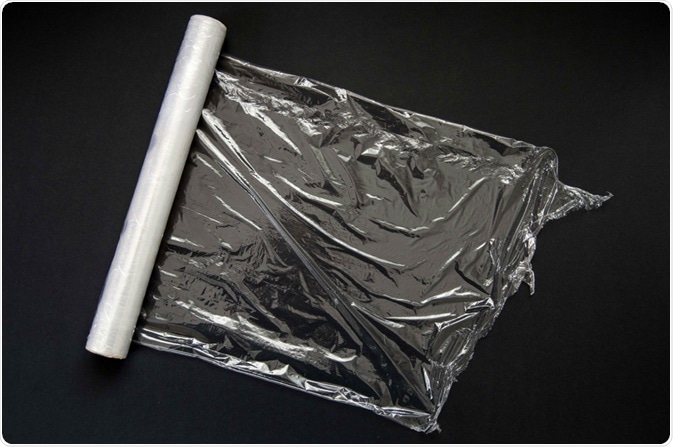Illicit drugs distributed worldwide are commonly packaged in cling film. The characterization of the polymers, as well as their chemical compositions, serve as a tool to aid forensic investigators to link a questioned drug to a known cling film.

Cling Film. Image Credit: hanif66/Shutterstock.com
Studies have discovered instruments that can provide different characterizations regarding the cling films used to wrap common drugs of abuse. These include gas chromatography/combustion/isotope ratio mass spectrometry (GC/C/IRMS), elemental analysis/isotope ratio mass spectrometry (EA/IRMS), GC/MS, and ATR-FTIR.
Manufacturing of cling film provides identification
Cling films are typically analyzed through a polythetic approach that compares the physical, as well as chemical, characterizations of the cling film material. Cling films are composed of the base polymer polyvinylchloride (PVC) or low-density polyethylene (LDPE).
While cling films have been composed of halogenated polymers and plasticizers such as DEHA, DBP, and DEHP, manufacturers have moved into LDPE to avoid contamination of food from such chemicals. Also, manufacturers often perform co-polymerization between vinyl acetate and LDPE to form ethylene vinyl acetate (EVA), generating resistance to oxidation and withstanding the power of UV and visible light.
Whereas PVC films are added with plasticizers to gain flexibility from the rigid cling film material. In addition to these processes, cling films, as well as other plastic films, undergo the blown film extrusion technique during manufacturing, and this process forms striation marks caused by the damage from the extrusion.
The striation marks, or commonly referred to as the die lines, can aid forensic examiners to associate a section of cling film to another by aligning the continuous die lines. The two pieces of the cling film can then be linked by Schlieren photography or shadowgraphing.
Nevertheless, other existing physical methods that do not involve the arrangement between the two cling film bits are also employed.
Observation of the unique characteristics from crystalline additives by stereomicroscopy or determination of birefringence through polarized light microscopy can provide physical characterization.
ATR-FTIR spectroscopy identifies the different base polymers in a cling film
Due to the limitations at which cling films may distort or stretch; this produces disparities of the polymer thickness and shape during the examination of the die lines. Difficulties in arranging the two cling film pieces also exist due to the absence of seal features on the material.
A more favorable method of examining these materials is through using a chemical analysis approach, where a variety of chemical components within the cling film can be characterized.
Qualitative analysis of cling films by ATR-FTIR spectroscopy proves that the manufacturing process produces a homogenous mixture of all the chemical components in the film. This is due to the similarities of all spectra that are generated within different parts of a cling film roll.
The identification of base polymers in a cling film allows investigators to link an unknown cling film to its manufacturer. For instance, Sharma et al. was able to identify the presence of dioctyl adipate (DOA) and dioctyl phthalate (DOP) from its absorbance peak of 1738 cm-1, where the C=O stretch carbonyl group usually absorbs.
These peaks show stronger absorbance peaks in one particular cling film group sample than in another cling film group which signifies that the two films are manufactured differently.
False-positive arising from limitations from chemical variation quantification in LDPE cling films by ATR-FTIR
From analyzing different food grade LDPE cling films from separate brands with ATR-FTIR spectroscopy, Holam et al. found that qualitative comparisons are not as meaningful as quantitative analysis, as the peak wavenumbers would be similar for every cling film sample. Quantitative analysis would allow the cling films to be differentiated based on the difference in peak areas corresponding to the number of chemical components present in that cling film.
However, they also found that the chemical variation existing between different cling film samples can be very limited as the data points on the bivariate plots utilized show that the peaks overlap.
Although ATR-FTIR spectroscopy may not provide discrimination of different LDPE cling films, the technique remains a useful approach to identify the base polymer of a cling film in a rapid manner.
EA/IRMS can distinguish heroin seizures and cling films from isotopic measurements
Findings show that illicit heroin seizures and cling films can be characterized based on their isotopic compositions. Idoine, et. al utilized EA/IRMS instrumental analysis in distinguishing most of the heroin samples in bulk based on the Carbon, Nitrogen, Oxygen, and Hydrogen isotopes.
The hydrogen and oxygen isotope measurements were taken by the ThermoFinnigan TC/EA high-temperature elemental analyzer, and the GC column separated the carbon monoxide as well as the hydrogen that was formed in the pyrolysis reactor. The gaseous hydrogen and carbon monoxide were then used as references for the isotopic compositions, and these isotopic compositions were calibrated against PEF1 polyethylene foil and NBS19 calcium carbonate.
Their findings demonstrate that cling films can be discriminated mainly based on the Carbon 13 isotope values between the different heroin seized drugs, alongside the hydrogen, oxygen, and carbon isotopic ratio multivariate comparisons. This method can assist investigators in associating seized heroin drugs with various street deals.
References
- Telford, C.J., Burrows, B.A., Sauzier, G., van Bronswijk, W., Houck, M.M., Maric, M., and Lewis, S.W. (2017). Classification of polyethylene cling films by attenuated total reflectance-Fourier transform infrared spectroscopy and chemometrics. Analytical Methods, 9(2), pp.192-197. https://pubs.rsc.org/en/content/articlehtml/2016/ay/c6ay02960d?casa_token=Qks9_seOKsQAAAAA:hOrlza8hrsISNqlbqLwDl8pzptM-c8HJgaLeLUE6BLiH9k-ADBdEk7hlwT1HvY5iyatHzaSDgNf17bFU
- Sharma, V., Nani, D., and Kumar, R. (2019). Spectroscopic and chemometric evaluation of cling films used for wrapping of foodstuff and illicit drugs. Spectrochimica Acta Part A: Molecular and Biomolecular Spectroscopy, 206, pp.558-568. https://www.sciencedirect.com/science/article/pii/S1386142518308291?casa_token=wqRwS9UVwacAAAAA:Jw51RhMkzikP94TRvg-K7tJHp5ossse9NPLO4yXLYcvZ5-Rg4-OM7cn_Hn6Tbw0qc6EVBDfST4vg
- Idoine, F.A., Carter, J.F., and Sleeman, R. (2005). Bulk and compound‐specific isotopic characterisation of illicit heroin and cling film. Rapid Communications in Mass Spectrometry: An International Journal Devoted to the Rapid Dissemination of Up‐to‐the‐Minute Research in Mass Spectrometry, 19(22), pp.3207-3215. https://onlinelibrary.wiley.com/doi/epdf/10.1002/rcm.2153?saml_referrer
Further Reading
Last Updated: Aug 17, 2022